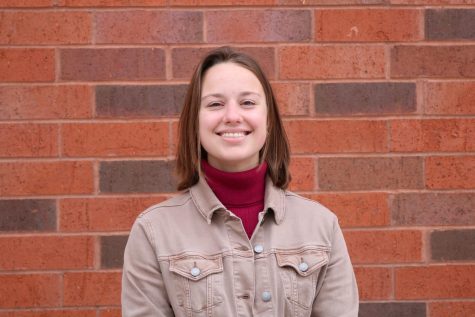UW-Eau Claire named a ‘Tree Campus’
UW-Eau Claire’s nearly campus-wide arboretum fosters a healthy environment for trees
Photo by Lindsey Ambrosius
During a walk guided by Daria Hutchinson, Joe Rohrer and Matt Staudenmaier, students and community members were encouraged to ask questions about the trees that call the UW-Eau Claire campus their home.
A pin oak tree personifies perseverance. Naturally growing in a difficult, swampy habitat, the tree prospers in adversity, a botanist from UW-Eau Claire said during a guided walk through the campus’ arboretum on Monday afternoon.
“This tree has a pre-adaptation to survive the hard stuff,” said Joe Rohrer, a botanist and a professor in the department of biology.
From behind a chain link fence encircling the Pin Oak, Rohrer pointed at its towering branches. The pin oak’s tough characteristics are what have made its kind survive amid the hubbub of construction on Eau Claire’s lower campus.
The pin oak was just one of 15 tree species featured during the event. The walk coincided with the university’s designation as a Tree Campus USA college and celebration of Arbor Day.
Two other experts lead the walk beside Rohrer: Matt Staudenmaier, a forester for the City of Eau Claire, and Daria Hutchinson, UW-Eau Claire’s landscape designer.
In addition to keeping the pin oak’s roots safe from heavy equipment with the fence, mulch was spread to prevent temperature extremes from damaging the roots of the oak, Hutchinson said.
“Life on campus is not easy,” Hutchinson said, speaking for the trees.
Nurturing extends beyond the pin oak — every species of tree on campus is cared for uniquely. And this is not a small job; there are 91 different species found in the arboretum, which encompasses both the upper and lower campuses.
The trees in front of Schneider Hall are fitted with white collars to prevent branch breakage; the white pine sits in the shade it enjoys; the Marmo maples are advantageously clipped.
“This is very controlled and reasoned,” Staudenmaier said. “If you see someone pruning a tree, don’t freak out.”
Pruning allows trees to keep the shape they would in nature, Staudenmaier explained, where they face “competition” for space to spread their branches in the forest.
This special attention to detail, part of the campus tree care plan, is one of the qualifiers that earned Eau Claire recognition from Tree Campus USA. In order to be certified by the organization, the university also needed a campus tree advisory committee, recognize Arbor Day annually, have a dedicated annual budget for its tree program and a student service-learning project related to tree plans.
It took various departments to meet these standards. They include the Watershed Institute, the Student Office of Sustainability (SOS), the facilities management division and the departments of biology, geology and anthropology. The groups also collaborated to create the arboretum.
Kristina Haideman, the SOS director, said Student Senate’s unanimous support of a resolution backing Eau Claire’s recent certification and arboretum creation is a hopeful sign. Senate approved a Green Fund allocation of $13,500 to maintenance of the Tree Campus USA program.
“I think trees are very great for students because, at least for me, they bring excitement,” Haideman said.
Trees often signal seasonal change, Haideman said, and beautify the campus’s aesthetic. The sudden absence of trees leaves a noticeable change that proves their value.
Kaisa Kough, an environmental geology student, said Monday’s clear skies provided perfect weather for a tree walk.
“It spreads awareness, so people know what’s here, (and) so people are educated about trees,” Kough said.
Monday’s tree walk concluded with a Tree Campus/Arboretum dedication. Brad Johnson, the area’s urban forestry coordinator from the Wisconsin Department of Natural Resources, presented Chancellor James C. Schmidt with a plaque honoring UW-Eau Claire’s Tree Campus designation.
“We’re proud to be certified as a Tree Campus USA college, thanks to the outstanding collaboration of our faculty, staff and students over the past several years,” Schmidt told the university’s integrated marketing and communications department. “Much effort and expertise has gone into creating a diverse campus arboretum that will be enjoyed by campus and community and preserve the beauty of our campus for years to come.”

Neupert is a fourth-year journalism student at UW-Eau Claire. She is the executive producer of Engage Eau Claire on Blugold Radio Sunday. In her spare time, Neupert's working on becoming a crossword puzzle expert.

